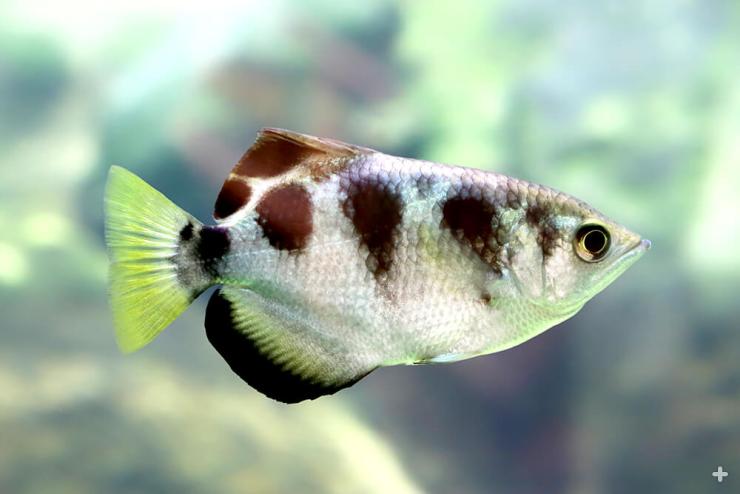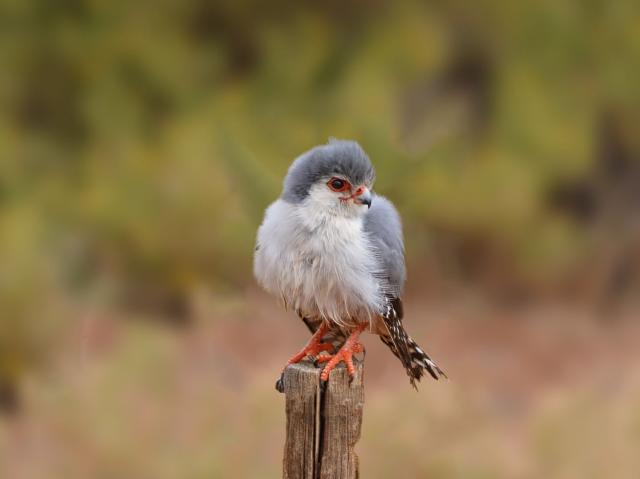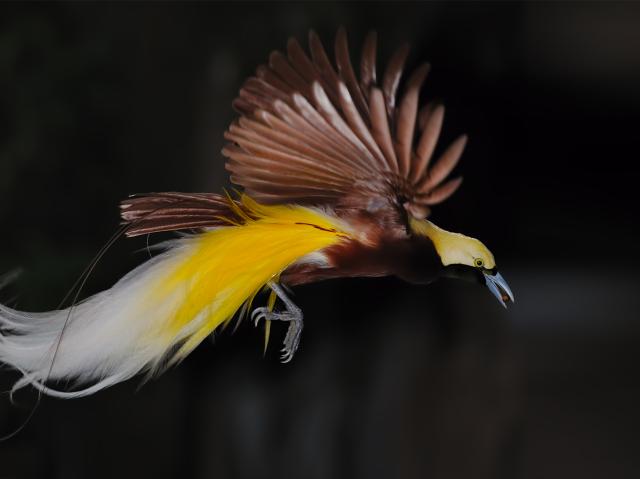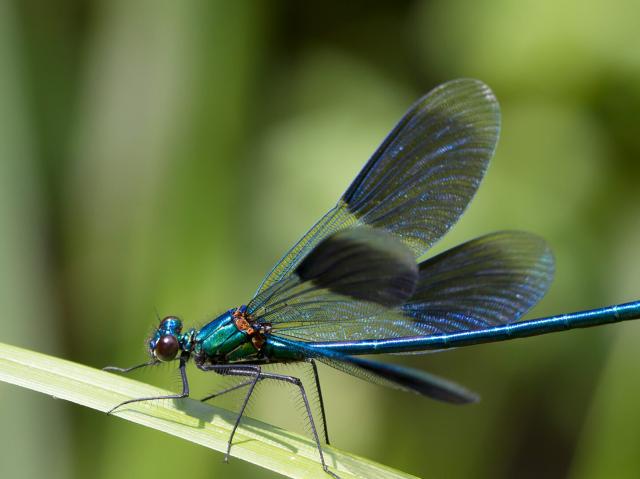
Banded Archer Fish

- Class: Actinopterygii
- Order: Perciformes
- Family: Toxotidae
- Genus: Toxotes
- Species: jaculatrix

ABOUT
Taking aim. While the banded archer fish (or archerfish) may look like an ordinary fish, the way they capture prey will stop you in your tracks. This carnivorous fish has a powerful “super soaker” built in. The fish float near the surface of the brackish water they prefer, awaiting spiders and insects. Once a tasty bug is directly above them, they shoot a powerful stream of water to knock the insect into the water! If at first they don’t succeed, this fish can shoot up to seven streams in one mouthful of water. Should it still miss the target, this fish has the ability to jump out of the water with enough momentum to chase down its meal.
The name archer fish reflects its ability to take down prey both underwater and above the water by spitting an “arch” of water at it.
Thin set. Archer fish have an elongated body that is laterally compressed, making it rather thin. The shape of its face is pointy around the mouth. This narrow profile allows it to have precise aim when taking down prey. This fish can grow 10 to 12 inches (25 to 30 centimeters) in length. The dorsal fin sits farther back than most fish and the tail is rounded.
Body bands. There are seven different species of archer fish, and all vary in band pattern. The most common is the banded archer fish. Their body is silver with a gold tint across the back. They have four to six vertical bands across the body. The first one drapes across the eye and the last is around the anal fin. The other types of archer fish are all similar in color, but some do have spots and/or fewer bands.
Fish eyes. Archer fish have more developed eyes than most fish. The binocular vision allows them to focus forward and judge longer distances to aid their hunting technique. While archer fish mouths go above the surface to shoot down prey, the rest of the body remains submerged. Their eyesight does not account for refraction of light against the water, so they must learn to aim for accuracy. Small fry quickly learn the best place to see a prey item is directly underneath it.
HABITAT AND DIET
Wet world. Archer fish can be found in estuaries with brackish water around mangroves. (Brackish water is the combination of both salt and freshwater.) They often venture into lakes and rivers in search of food. These fish migrate to saltwater and freshwater areas; however, they do not do so for breeding like most other fish. Archer fish are widespread geographically, ranging from East Africa, through the coastal waters surrounding Asia, all the way to Australia.
Sharpshooters. Archer fish make their home near the surface of brackish waters, but they also explore streams and rivers. They tend to stay near the surface for finding prey and for spawning.
Archer fish spend the majority of the day swimming near the surface of the water looking for prey. They are excellent hunters. They have been known to leap out of the water to catch insects and spiders. Archer fish shoot a stream of water out of their mouths to knock flying prey items out of the air; they have great aim, too. These fish have been observed shooting at prey 5 feet (1.5 meters) above the surface of the water. When preparing to take down prey, they suck in water, place their tongue on the roof of their mouth, and then shoot. The mouth protrudes above the surface for best aim. With one gulp of water, they can shoot six to seven times.
Watch out! Predators threatening the archer fish include humans, other larger fish, and even birds of prey. These fish are agile swimmers, making it easy to dart away from other larger fish and birds of prey. While they prefer to stay near the surface of the water, they are capable of swimming deep to avoid incoming talons. Humans, however, prove to be a persistent predator by collecting them for the pet trade.
Food for thought. Archer fish are primarily carnivores. They feast on insects, spiders, smaller fish, and crustaceans. These fish mainly hunt on the surface for food, which can make it tricky to feed them in managed care. Once the food falls under the surface, archer fish tend to leave it alone. At the Zoo, the archer fish feast on crickets and mealworms.
FAMILY LIFE
Fish family. Archer fish live in a schooling group. They do best in smaller groups of about four individuals. Since they are predators and can prey on smaller fish, they do best when those in the school are all of similar size. They tend to remain at the surface for feeding; they won’t bother other fish that remain at lower water levels. Little is known about their communication among individuals.
Archer fish are extremely difficult to breed in managed care; in fact, it is a rare occurrence. One reason is that it is impossible to determine the sex of these fish. When it does happen, though, these fish can spawn up to 3,000 eggs at once! The eggs float on the surface of the water and hatch after 12 hours. The newly hatched fry are a few centimeters long and are on their own right away—no parental care required. These fry start learning how to shoot water out of their mouths quickly, or they will go hungry. Even as youngsters, their jet streams of water shoot up to about 7 inches (18 centimeters)!
Tools of the trade. At an aquarium in Portsmouth, England, the archer fish were hand fed and soon stopped shooting water at prey. The staff set up a mobile using plastic flies covered with fish food to get the archer fish to begin shooting again. This type of enrichment helped the fish get back to their trademark hunting behavior.
CONSERVATION
Uncommon hunter. While its hunter techniques are unusual, archer fish are quite common. But like all marine life, they are threatened by habitat destruction and pollutants in the water. These fish are collected from the wilderness for the pet trade. The IUCN Red List of Threatened Species lists five types of archer fish—zebra, banded, primitive, small scale, and big scale—all with “stable” or “unknown” population trends.
LIFE SPAN
About 2 years in the wilderness; 10 years in expert care
YOUNG
About 3,000 eggs laid per clutch
Eggs can hatch within 12 hours after spawning
SIZE
Up to 12 inches (30 centimeters) long
FUN FACTS
The name archer fish reflects its ability to take down prey both underwater and above the water by spitting an “arch” of water at it.
The Toxotes genus is very small, containing only seven species.
"Toxotes," the genus name, is Greek for "archer," while the species name "jaculatrix" is a Latin word for a female javelin thrower.
The World War II submarine the USS Archerfish was named after this sharpshooting fish.











